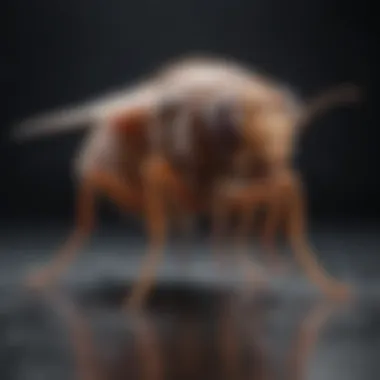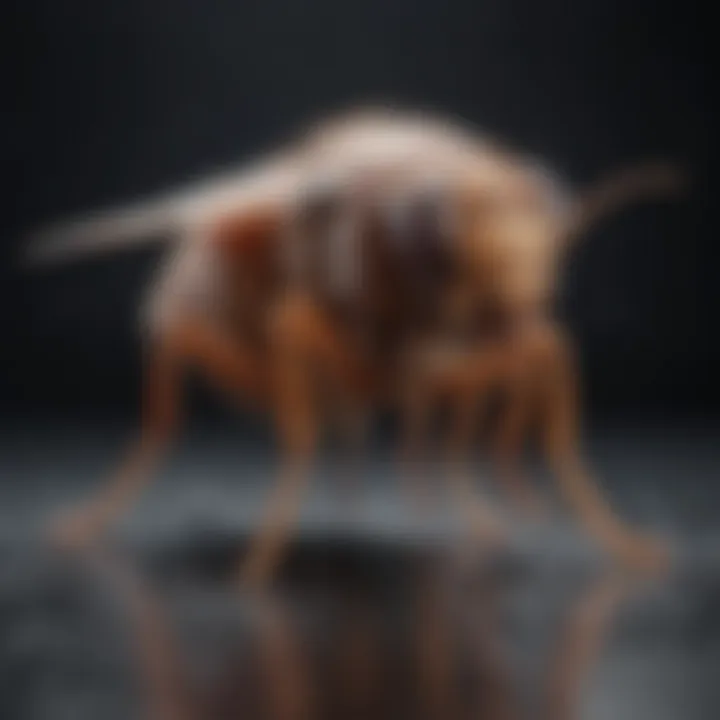Safe Flea Bombs for Pets: A Comprehensive Guide


Intro
The presence of pests in our living spaces can be more than just an inconvenience. Fleas, in particular, pose a significant problem for pet owners. Understanding how to combat these pests effectively, while ensuring the safety of our pets, is crucial. This article delves into flea bombs, exploring their safety, types, and applications. The goal is to provide pet owners with the necessary insights for making informed decisions in pest control.
Understanding Pests
Definition of Pests
Pests are organisms that negatively affect human activities, whether they invade our homes, gardens, or livestock. They can be insects, rodents, or other creatures that disrupt our daily lives. Common household pests include ants, rodents, and especially fleas, which thrive in environments with pets. Understanding what pests we face is the first step in combating infestations effectively.
Importance of Pest Identification
Identifying the specific pest is crucial. Fleas, for instance, have particular habits and lifecycle characteristics that dictate how they should be treated. Correct identification allows homeowners to choose appropriate control methods, such as flea bombs. Moreover, recognizing when to call a professional can prevent further infestations.
Prevention Techniques
Home and Garden Preventative Measures
Preventing fleas from invading your home is oftentimes better than reacting after an infestation occurs. Here are some effective measures:
- Keep your home clean by regularly vacuuming carpets and furniture. Don't forget to dispose of the vacuum bag immediately.
- Wash pet bedding frequently in hot water to eliminate any fleas or eggs.
- Invest in flea preventative treatments for your pets, such as topical treatments or oral medications.
Seasonal Prevention Tips
- During warmer months, fleas can become particularly active. It's wise to increase prevention efforts as the weather warms.
- Keep your yard well-maintained. Trim grass and bushes to minimize hiding places for fleas.
Eco-Friendly Pest Control Solutions
Overview of Sustainable Practices
For those wary of harsh chemicals, eco-friendly pest control solutions are increasingly available. These methods aim to minimize environmental damage while effectively eliminating pests. Flea bombs exist that use natural ingredients, such as essential oils, which can be safer for pets and humans alike.
Natural Remedies and Their Effectiveness
Natural remedies often appeal to pet owners concerned about safety. Some commonly used natural ingredients include:
- Diatomaceous earth: This powder can be spread in infested areas to dehydrate fleas.
- Essential oils: Oils such as lavender or cedar can deter fleas but should be used cautiously, as some are toxic to pets if concentrated.
"Choosing the right pest control solution is essential not just for effectiveness but also for ensuring your pet's safety."
Understanding fleas and the safe methods for controlling them can protect both pets and the environment. It's critical to assess potential solutions thoroughly, weighing the effectiveness against safety before making decisions. The next sections will delve deeper into specific flea bomb options and best practices for application.
Intro to Flea Bombs
Flea bombs are a vital tool for pet owners in tackling flea infestations effectively. These products serve a dual purpose. Firstly, they eliminate adult fleas and their larvae in various environments. Secondly, they help maintain a pest-free area for pets and humans alike. The importance of understanding flea bombs cannot be understated. With the right knowledge, pet owners can select safe products that do not endanger the health of their furry companions.
Pet owners face numerous challenges when dealing with flea infestations. Fleas are not just an annoyance; they can cause significant discomfort and health issues for pets. Thus, the use of flea bombs offers a quick solution to widespread infestations. However, safety is a primary concern. Many traditional flea bombs contain harmful chemicals which may be toxic to pets. Therefore, it is essential to choose flea bombs specifically designed to ensure pet safety. This article will analyze various types of flea bombs, ingredients to look for, and safe application methods to provide a comprehensive guide for pet owners.
What Are Flea Bombs?
Flea bombs, also known as foggers, are insecticides intended to control flea populations in specific spaces. They release a pesticide mist or fog that settles into cracks and crevices where fleas thrive. This method targets both adult fleas and their offspring. The design of flea bombs aims for ease of use. Pet owners simply set off the fogger and leave the treated area for a specified time.
However, it is crucial to distinguish between different types of flea bombs on the market. Some incorporate natural ingredients, while others use synthetic chemicals. Understanding these differences helps pet owners make informed decisions. Safe flea bombs typically rely on natural or pet-safe ingredients. Such options may include essential oils that repel fleas without harmful side effects.
How Do Flea Bombs Work?
Flea bombs function through a process of aerosolization. When activated, these devices release pesticides into the air. The small droplets of insecticide settle on surfaces, effectively reaching areas that may be difficult to treat manually. This technique allows for deeper penetration into carpets, furniture, and other habitat areas frequented by fleas.
Flea bombs typically contain a combination of pesticides. In most cases, these include adulticides, which kill adult fleas, and insect growth regulators. The latter disrupt the life cycle of fleas, preventing the development of larvae into adults. This dual action effectively reduces flea populations within a short time frame.


It is important to note that a flea bomb alone may not entirely eliminate fleas. Ongoing treatment and preventive measures are necessary to maintain a flea-free environment.
In combining their effectiveness and the convenience of application, flea bombs present a compelling option for pest control. Nevertheless, caution should be exercised in choosing flea bombs, especially with pets in the home.
The Importance of Safety for Pets
For pet owners, ensuring the safety of their animals is paramount. When dealing with flea infestations, it's essential to choose treatments that do not compromise pet health while effectively eradicating pests. This article emphasizes safety not just as a precaution but as a responsibility. Using flea bombs requires an understanding of ingredients and potential risks involved. It is fundamental to acknowledge that not all flea bombs are created equal.
Potential Risks of Flea Bombs
Flea bombs, while effective in controlling pest populations, can pose significant risks to pets if not used correctly. The primary concern is the chemical composition of many flea bombs. Some contain potent insecticides that may be harmful or even toxic to animals. Pets are often more sensitive to these chemicals due to their size and biology. If a flea bomb is used in a space where pets frequent, there can be severe consequences.
Pet owners must ensure adequate ventilation and consider the retreatment time following application. Ignoring these aspects may lead to situations where pets experience adverse effects like nausea, respiratory issues, or skin irritations. Therefore, it is advisable to read labels thoroughly and understand the ingredients involved in any flea bomb products.
Pet-Related Health Concerns
Health concerns related to flea bomb use extend beyond immediate reactions. Long-term exposure to certain chemicals may lead to chronic health issues in pets. Some pets may develop allergies to the fumes or residues from flea bombs, leading to ongoing discomfort or worse. Additionally, ingestion of any residual chemicals on surfaces can result in gastrointestinal distress and other serious health problems.
Moreover, it is vital for pet owners to be aware of specific sensitivities their pets may have. For example, cats are particularly vulnerable to certain insecticides that are safe for dogs. Always consult with a veterinarian before deciding to use flea bombs in homes with pets. Protective measures ensuring the safety of animals are far more responsible than retrospective actions taken after a health incident occurs.
Always prioritize your pet's safety when considering flea treatments. Read all labels and consult with a veterinarian to mitigate risks associated with chemical exposure.
Ensuring the safety of pets when using flea bombs is not merely a matter of preference but a crucial duty. Understanding both potential risks and health concerns allows pet owners to make informed choices, ultimately protecting their beloved companions.
Types of Flea Bombs
Flea bombs, or foggers, play a crucial role in managing flea infestations. Understanding the different types is essential for effective pest control and pet safety. Each type of flea bomb has unique characteristics, benefits, and potential drawbacks. A thorough comprehension of these categories helps homeowners make informed choices suitable for their circumstances.
Insect Growth Regulators
Insect Growth Regulators (IGRs) are designed to disrupt the life cycle of fleas. These products do not kill adult insects directly; instead, they prevent larvae and eggs from developing into adult fleas. The advantage of IGRs is their long-lasting effects, as they suppress new fleas from emerging for an extended period.
Key benefits include:
- Reducing flea populations over time
- Decreasing the need for frequent applications
- Minimizing chemical exposure for pets and humans
Common IGRs include Pyriproxyfen and Methoprene. Both are effective and widely used in the pet care industry. They can protect your home by preventing infestation resurgence, making them an excellent option for pet-friendly environments.
Natural Flea Bombs
Natural flea bombs leverage plant-based ingredients to create a safer environment for both pets and their owners. These products often contain essential oils or other natural extracts that repel fleas without the harsh chemicals found in many traditional bombs.
Advantages of natural flea bombs:
- Generally considered safer for pets and humans
- Less likely to cause allergic reactions
- Often easier on the environment
Examples include products made with peppermint oil, cedarwood oil, or citrus extracts. While natural options may require more frequent applications, they provide a non-toxic alternative for those who prioritize safety.
Chemical Flea Bombs
Chemical flea bombs typically contain potent insecticides that target adult fleas effectively. While these products can provide rapid elimination, they come with higher risks regarding safety for pets and humans. Careful selection is vital when choosing chemical flea bombs, as some ingredients can be harmful to your pets.
Benefits of chemical flea bombs:
- Immediate results in eliminating visible fleas
- Wide availability and numerous options
- Often effective against multiple pests, such as ticks
However, safety precautions are paramount. Always ensure your pets are removed from the treated area during and after application, as exposure can lead to health issues.
In summary, knowing the differences among these types of flea bombs helps pet owners select the most suitable option while mitigating risks. Each type offers distinct advantages and considerations, making it essential to evaluate them against personal needs and the safety of pets.
Choosing Safe Flea Bombs for Pets


The selection of safe flea bombs is of paramount importance for pet owners seeking effective pest control solutions. A well-informed choice not only alleviates the immediate concerns of flea infestations but also safeguards the health and well-being of pets. By understanding both the ingredients and the safety records of different brands, pet owners can effectively mitigate risks associated with pesticide exposure. It is essential to recognize that not all flea products are created equal. Some may pose significant risks to pets, while others have been specifically formulated to ensure safety alongside efficacy.
Understanding the nuances of safe flea bombs aids pet owners in making educated choices, minimizing potential health threats, and ultimately promoting a healthier living environment for both pets and humans. As we delve deeper into selecting safer options, we can shed light on the key ingredients to look for and highlight brands that prioritize pet safety in their formulations.
Key Ingredients to Look For
When evaluating flea bombs, it is crucial to scrutinize their ingredients list. Some substances are more likely to be safe for pets than others. Key ingredients that generally signify safer options include:
- Insect Growth Regulators (IGRs): These disrupt the flea life cycle without necessarily affecting pets. Products containing methoprene or pyriproxyfen are notable examples.
- Natural Extracts: Ingredients like cedar oil or neem oil can act as repellents. They are derived from plants and tend to pose fewer risks than synthetic chemicals.
- Low-Volatility Rodenticides: Certain formulations are designed to minimize harmful vapors. Look for those with lower volatility ratings, ensuring they are less likely to be inhaled by pets.
- Non-Toxic Fillers: Ingredients found in natural products, such as diatomaceous earth, can be effective at controlling fleas while being safer for pets.
By highlighting these specific ingredients, pet owners can better assess the safety of their chosen flea bombs and reduce exposure risks.
Brands Known for Safety
There are multiple brands committed to creating flea control products geared toward safety for pets. Choosing reputable and reliable brands can significantly lessen the risk associated with flea bomb usage. Some brands that have garnered positive attention include:
- Hot Shot: Known for its focus on pet-friendly formulas, it often incorporates safer ingredients in its flea bomb products.
- Vet's Best: This brand emphasizes natural solutions, using plant-derived ingredients that are less harmful to pets while remaining effective against fleas.
- EcoSMART: Guaranteed to be free of harmful chemicals, EcoSMART products leverage natural botanical ingredients to eliminate pests without posing safety threats to pets.
By favoring these brands, pet owners can ensure they are investing in products that prioritize health and safety, thus alleviating concerns while effectively managing flea infestations.
Application Methods
Application methods are vital for the effective use of flea bombs. A proper application ensures maximum efficacy while minimizing exposure to both pets and humans. The following sections provide essential guidance regarding the preparation before use, the actual steps for effective application, and the necessary precautions post-application. Understanding these elements is critical to harness the potential of flea bombs in an efficient manner, keeping the environment safe for your beloved pets.
Preparation Before Use
Before deploying a flea bomb, preparing the area is crucial. This step can significantly affect the effectiveness of the treatment. Here are some key considerations:
- Remove Pets and People: Ideally, all pets and humans should vacate the premises. This ensures that they avoid exposure to any chemicals released during the process.
- Clear the Area: Remove any items that can obstruct the fumigation process; think about toys, food, and delicate furnishings. The more unobstructed the area is, the less chance of the chemical being absorbed by these materials.
- Check for Hazards: Make sure there are no flammable materials nearby. This is particularly important with certain types of chemical flea bombs.
- Read Instructions: Each flea bomb is different; thorough reading of all included instructions ensures safe and effective use based on the specific product chosen. It's essential not to rush this stage.
Steps for Effective Application
Following the preparation stage, executing the application correctly is the next step. Each flea bomb will have particular instructions, but there are general steps you may follow:
- Ventilation: Ensure the room is closed off from others, but allow for some ventilation to prevent a build-up of fumes. This will help keep the indoor air quality safe when you return.
- Positioning the Bomb: Place the flea bomb on a level surface in the center of the room. Adequate spacing from walls and furniture will ensure that the fog or mist can disperse evenly throughout the space.
- Activate the Bomb: When the bomb is prepared, follow the manufacturer's instructions to activate it. This process may involve pressing a lever or turning the product to an active positioning.
- Leave the Area: Once activated, you should exit the area immediately. Close doors behind you to confine the flea bomb’s action to the treated space.
Post-Application Precautions
After the application, it is essential to handle the area with caution. Here are some necessary post-application steps:
- Wait Period: Follow the designated wait time as indicated on the flea bomb packaging. This ensures that the chemicals have time to work effectively against fleas but also limits exposure upon re-entry.
- Ventilation After Treatment: Once the wait time has elapsed, thoroughly ventilate the rooms. Open windows and doors to facilitate fresh air circulation, flushing out any residual chemical vapors.
- Cleaning Surface Areas: After returning, clean any surfaces that pets may come into contact with. This can include floors, countertops, and furniture surfaces, as chemicals can linger on these areas.
- Monitor Pets: Watch your pets for any signs of discomfort upon re-entry. If any adverse reactions are noted, consult a veterinarian. It’s better to be cautious with their health.
It’s imperative to always prioritize safety for both pets and humans when using flea bombs, as improper use can lead to negative health outcomes.
By following these structured application steps, pet owners can maximize the benefits of flea bombs while keeping their homes safe from harmful pests.
Effectiveness of Flea Bombs
Flea bombs serve as a critical tool for eliminating flea infestations in homes, especially for those with pets. The effectiveness of these products directly influences pet safety, household environment, and overall pest control. Understanding how effective these flea bombs are can help pet owners decide when to use them, how to use them properly, and in which situations they might consider other methods.
Comparison with Other Methods
When discussing effectiveness, it is essential to compare flea bombs with other pest control methods. Standard options include topical treatments for pets, sprays, and powders. Here is a breakdown of each method:
- Flea Bombs: These are designed to penetrate the entire room, reaching places where other treatments may not. They release a pesticide fog that can activate hard-to-reach areas effectively.
- Topical Treatments: Such as Advantix or Frontline, are applied directly to the pet's skin. They are effective at killing fleas on the animal but may not address the infestation within the environment.
- Sprays and Powders: These methods can be targeted to specific areas, providing immediate effects. However, they may require multiple applications and can be labor-intensive.
Flea bombs have a distinct advantage in treating larger infestations across multiple surfaces. Pet owners should also note that flea bombs often cover a broader area and can target both adult fleas and their larvae. Therefore, in terms of effectiveness, flea bombs may provide a more comprehensive solution when compared to other methods.
Expected Results and Limitations


While flea bombs can be effective, understanding their expected results and limitations is crucial for realistic expectations. The aim is to wipe out fleas quickly; however, complete elimination may not always happen in one go. Results depend on several factors:
- Severity of Infestation: Heavier infestations may require multiple treatments and a combination of methods for full control.
- Environmental Factors: Flea populations may rebound if not all areas, like carpets or upholstery, are adequately treated.
- Application Method: Following manufacturer instructions diligently is important. Inadequate use can severely limit success.
- Duration of Effectiveness: Many flea bombs eliminate fleas that are present at the time of application but may not prevent new infestations.
Using flea bombs will significantly reduce flea populations but should be part of an integrated pest management strategy. Regular cleaning and vacuuming, along with preventive treatments for pets, are vital steps to maintaining a flea-free environment.
Environmental Impact
Understanding the environmental impact of flea bombs is crucial for pet owners who are also conscientious about their surroundings. The use of chemicals in pest control can lead to significant ecological consequences. When selecting a flea bomb, it’s important to consider how its ingredient composition affects the local ecosystem. Some products can contribute to soil and water contamination while others may harm beneficial insects, birds, or other animals. Therefore, the benefits of using effective flea bombs must align with sustainable practices that promote environmental health.
Ecological Considerations
The ecological considerations surrounding flea bombs include their effects on non-target species and ecosystems. Many flea bombs contain powerful chemicals designed to eliminate pests. However, indiscriminate usage can lead to the collateral damage of important wildlife. For instance, certain insecticides can disrupt bee populations, which are essential for pollination.
Moreover, the persistence of these chemicals in the environment is a critical issue. Some compounds can remain in soil and water for prolonged periods, raising concerns about bioaccumulation in the food chain. Thus, understanding the long-term ecological ramifications of pest control products is essential.
- Biodiversity Impact: Flea bombs that utilize harsh chemicals may inadvertently harm local wildlife, leading to declines in biodiversity.
- Soil and Water Quality: Over time, the leaching of these chemicals can degrade soil health and contaminate water sources, impacting plant and animal life.
- Public Health: Chemicals in flea bombs can also pose a risk to human health through water supplies or airborne particles.
In light of these considerations, opting for flea bombs that prioritize eco-friendliness is prudent.
Sustainable Practices in Pest Control
Sustainable practices in pest control focus on minimizing the ecological footprint while effectively managing flea populations. Using flea bombs safely and responsibly can help in achieving pest control without compromising environmental integrity. Here are some sustainable practices:
- Choosing Bio-Based Products: Select flea bombs that use natural ingredients or are certified organic. These options tend to be less harmful to both pets and the environment.
- Integrated Pest Management (IPM): Implementing IPM strategies helps address pest problems through a combination of methods. These can include habitat management, biological control, and minimal chemical usage.
- Proper Disposal: Dispose of used flea bomb containers carefully. Follow local regulations to ensure hazardous waste is handled responsibly, preventing environmental contamination.
- Routine Cleaning: Regular cleaning of areas prone to fleas can reduce reliance on chemical treatments. Vacuuming, washing pet bedding, and maintaining yard hygiene help in flea prevention.
"Adopting environmentally sustainable practices transforms pest control from a purely chemical approach to a comprehensive strategy that safeguards both our pets and the planet."
By incorporating these sustainable practices when dealing with flea infestations, pet owners can protect their furry companions while safeguarding the environment. This conscious approach ensures that the health of the ecosystem is maintained, without compromising on the effectiveness of pest control.
Alternatives to Flea Bombs
The growing concern for pet safety has made many pet owners seek viable options aside from traditional flea bombs. This section examines such alternatives that can effectively control flea infestations without compromising the well-being of pets. Exploring these options allows homeowners to make informed decisions tailored to their specific circumstances. Identifying effective methods, understanding their benefits, and recognizing key considerations are essential for any pet-friendly home.
Natural Remedies
Natural remedies present a more gentle approach to flea control. There are several options that pet owners can consider.
- Diatomaceous Earth: This powdery substance is non-toxic to pets. When sprinkled in areas where fleas are likely to hide, it can help in dehydrating and killing fleas.
- Essential Oils: Certain essential oils, such as lavender, cedarwood, and lemongrass, are known for their flea-repelling properties. However, pet owners must exercise caution as not all essential oils are safe for pets. Dilution is key to avoid any adverse effects.
- Apple Cider Vinegar: A diluted solution of apple cider vinegar can act as a natural repellent when sprayed on pet fur. It may also help control fleas in the environment when mixed into cleaning solutions.
- Herbal Flea Collars: Making or purchasing collars infused with natural herbs can provide continuous protection for pets. Herbs like rosemary and mint can deter fleas while being safe for pets.
When using natural remedies, it's crucial to monitor pets for any signs of irritation or allergic reactions. Regular cleaning and frequent checks can enhance their effectiveness.
Preventive Measures
Preventive measures form the backbone of effective flea control. Implementing these strategies can reduce the likelihood of an infestation, ensuring a comfortable environment for pets.
- Regular Grooming: Frequent brushing of pets helps in identifying and removing fleas before they become a problem. Using flea combs can be particularly useful for this.
- Maintaining Cleanliness: Vacuuming carpets, upholstery, and pet bedding regularly can significantly diminish flea populations. Washing pet bedding in hot water at least once a week is essential.
- Outdoor Care: Keeping outdoor areas tidy and free from debris can reduce potential flea habitats. This includes mowing the lawn and removing standing water or piles of leaves where fleas might thrive.
- Pet Medications: Regularly consulting with a veterinarian about flea prevention treatments can be beneficial. Products like topical treatments or oral medications designed for long-term prevention can be effective.
Incorporating these preventive strategies with natural remedies enhances overall flea control efforts, resulting in a more holistic approach to keeping pets safe.
"Preventive measures can save you from the need for reactive treatments later on."
Exploring alternatives to flea bombs not only promotes pet safety but also fosters a sustainable approach to pest management in the home.
Ending
The conclusion serves as an essential component of understanding flea bombs that prioritize the safety of pets. This section encapsulates the critical insights discussed throughout the article while reinforcing the significance of making informed decisions regarding pest control. By bringing together the various elements covered, pet owners can see both the benefits and potential risks associated with using flea bombs in their homes.
Summary of Key Points
In summary, the key points highlight the importance of selecting flea bombs formulated with pet-friendly ingredients. Awareness of the types of flea bombs—like insect growth regulators, natural options, and chemical sprays—is crucial in choosing an effective solution. Understanding how flea bombs work, their potential risks to pet health, and the proper application methods ensures that owners are well-equipped to manage flea infestations safely. Additionally, considerations of environmental impact and possible alternatives, such as natural remedies and preventive measures, round out a comprehensive approach to pest control.
Final Recommendations for Pet Owners
For pet owners, the ultimate recommendation is to prioritize safety by selecting flea bombs clearly labeled as safe for pets. Look for products with effective, pet-safe ingredients that have positive reviews from other pet owners. Always read the instructions and adhere strictly to the recommended preparation and application methods. After using a flea bomb, it is advisable to keep pets away from treated areas for a specified time to minimize exposure. Regular maintenance, coupled with preventative practices like grooming and environmental cleaning, will further enhance the efforts to keep homes flea-free.
Having a clear understanding of flea bombs not only protects beloved pets but also fosters a healthier living environment.



